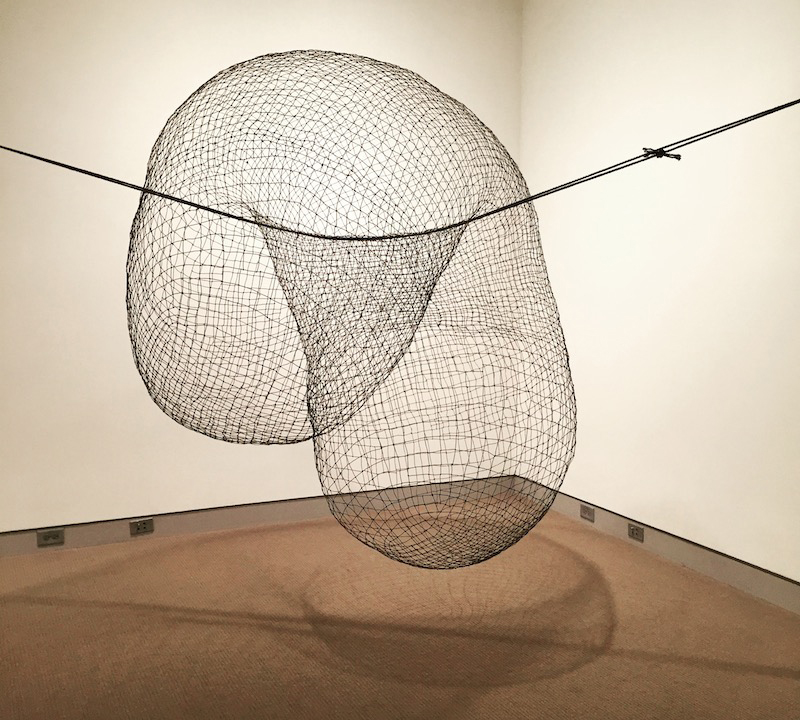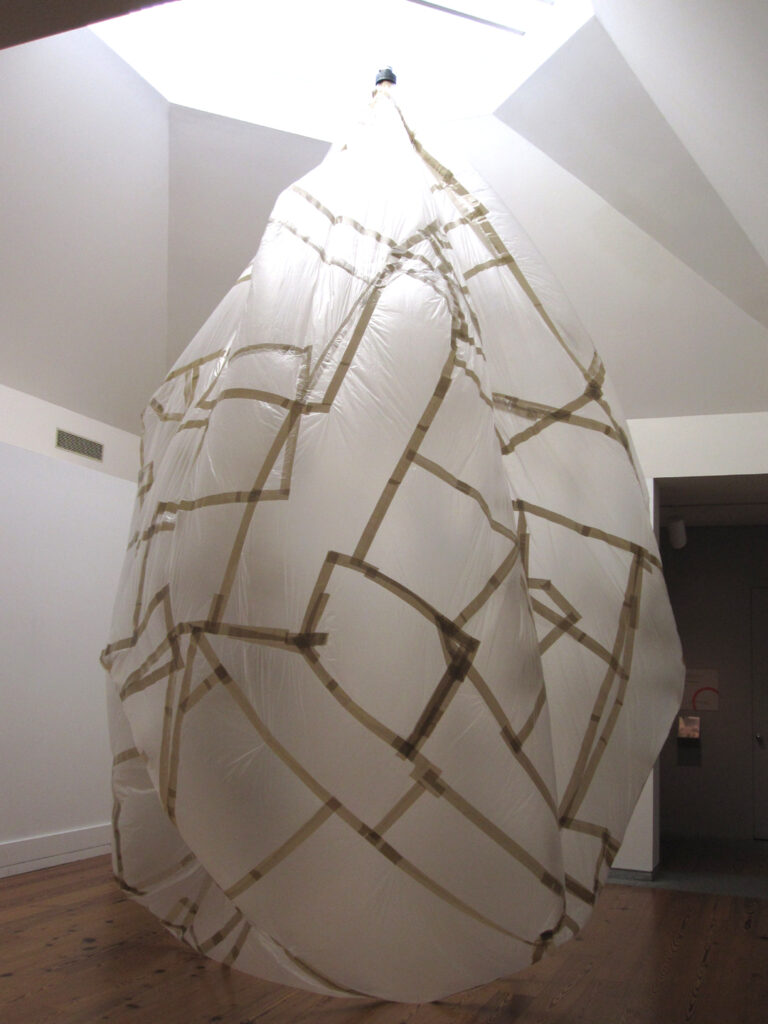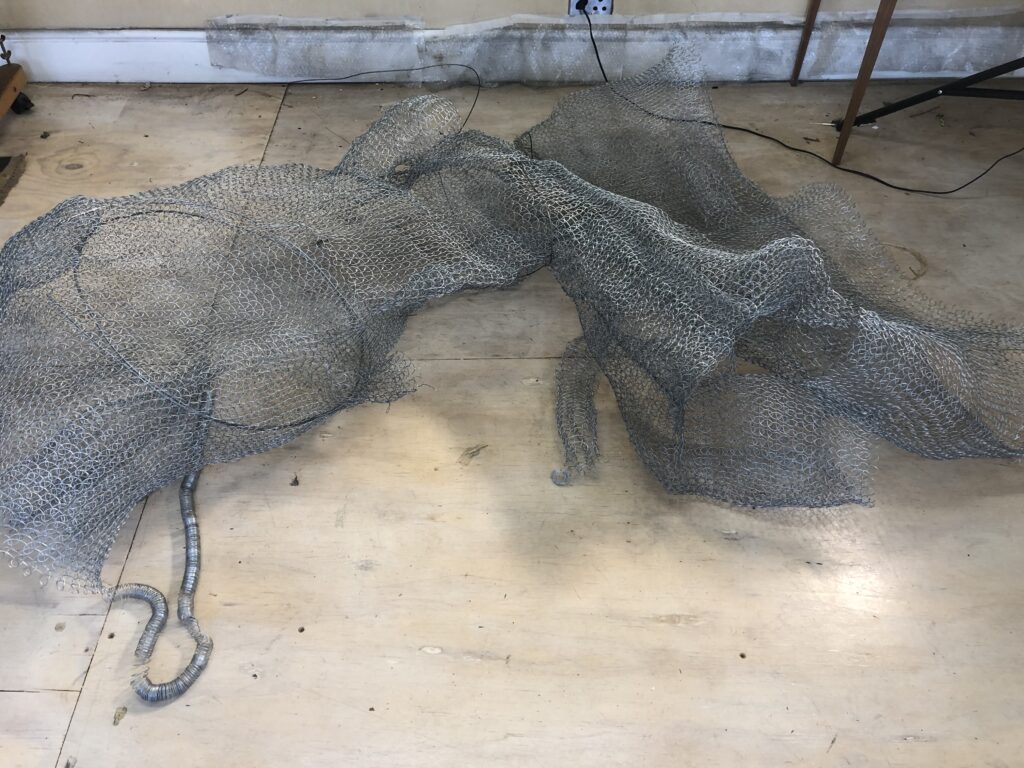Anna Hepler (b 1969- )
Hepler was a professor of art at Bowdoin College in Brunswick, but she has lived and worked on an island off the coast of Maine for the last four years.
The work below drew me to research this artist more. I hoped to understand why and how she explored with wire and its slumped form. In her work, there is a sense of interiority. It also seems that her creative world/studio becomes a private universe where she works with recurring shapes and images—her “elemental forms,” as she calls them—seem to evolve and curl into themselves in a state of continual reinvention. For years, she has explored this family of forms and motifs, flattening, stretching, and reconfiguring them – is it to pursue some fundamental core truth? I do like to think this is what is happening in my own search and exploration of materials. I also see a connection between her work and that of Ruth Asawa, who has greatly influenced my wire explorations.

Having read that, she has worked with air by showing how inflation and deflation contribute to form. I was fascinated by how this artist creates airy works, showing the material’s inherent floppiness at the same time. I love that the work challenges how one can almost reconfigure the form in its materiality. Perhaps she is best known for her massive inflatable sculptures made from recycled plastic that swell and crumple as if breathing.
“I want my sculptural forms to show simplicity and struggle at the same time.” Anna Hepler (https://angelaadams.com/anna-hepler/)

The work above, Full Blown, hangs from a skylight to receive natural light. It’s a translucent but relatively solid container for the compressed air that blows into it from a compressor above and inflates it every 16 minutes. Then, air slowly leaks out through the taped seams or thin plastic, and it goes to a deflated state. In the 2nd video below, you can see Hepler very excited to look inside the giant balloon.
I enjoyed the video below, as I thought I was the only person in the auditorium, and the talk was between me and this artist! I find it essential to say that it is incredible how we can feel connected to other humans through their art stories.
another video which touched me a lot: (https://recovergirl.wordpress.com/category/scraps/)
At this stage, I asked myself how to create volume and light in my work, Kalahari Hotel 2024 (WIP), as shown below. I am unsure if I want my work to hang or be suspended like a natural nest—I want to place it on the ground —but I need volume, which is not currently in the work. I used rigid wire circles to see if I could create volume inside the work. I am thinking about structuring and manipulating the work in its current form. Is it too late?

Anna Virnich (b 1984, Berlin)
Anna Virnich’s work is characterized by her use of materials such as cloth, wax, and plants, which she enhances with specially developed scents. This process allows her to explore and express her inner world and personal truths. Her creations, marked by their abstract and ephemeral nature, manage to create a strong presence that goes beyond traditional boundaries.
Anna Virnich also paints with oil pastel on the fabric, which had previously replaced paint and – in the case of the hand-made seam – the drawing pencil.
Before meeting Anna I’d read an article about her work in which she was identified as a ‘fabric painter’. I was curious if the artist herself aligns with this description.
“I mean, I don’t have a brush in my hand, but for me, this is definitely a painterly way of art… But a lot of people have a problem accepting it as painting because it’s not classical… In a way, it’s even getting a little bit more like sculpture when I’m working with transparent textiles as I can work with the space behind the piece.”
I asked what it is she finds so fascinating about textiles.
“For me, it’s the perfect tool. I am fascinated about spaces and weight of compression and how sharp a blank space can be in contrast to that. I can easily generate that with my ‘tool’ and through the different surfaces of the materials work with even more depth or three-dimensionality.”
“Textiles are so personal, but on the other side, so common. We live with textiles and we have them so close to us that they can be charged with memories. In a sexual way, a harsh way, or a comfortable way… We know the touch of textiles because we always have them on our body, and so the observer of the work gets a physical reaction.”
Lee Ufan
Lee’s philosophical bent found its expression in art through the Mono-ha movement that emerged in Japan during the social and political upheaval of the 1960s as a reaction against Western modernism. A co-founder of the movement, which translates as ‘School of Things’, Lee and his fellow members engaged in ‘not making’ art, with the belief that technology had rendered art-making obsolete, instead engaging with existing natural objects and manmade materials to create work.